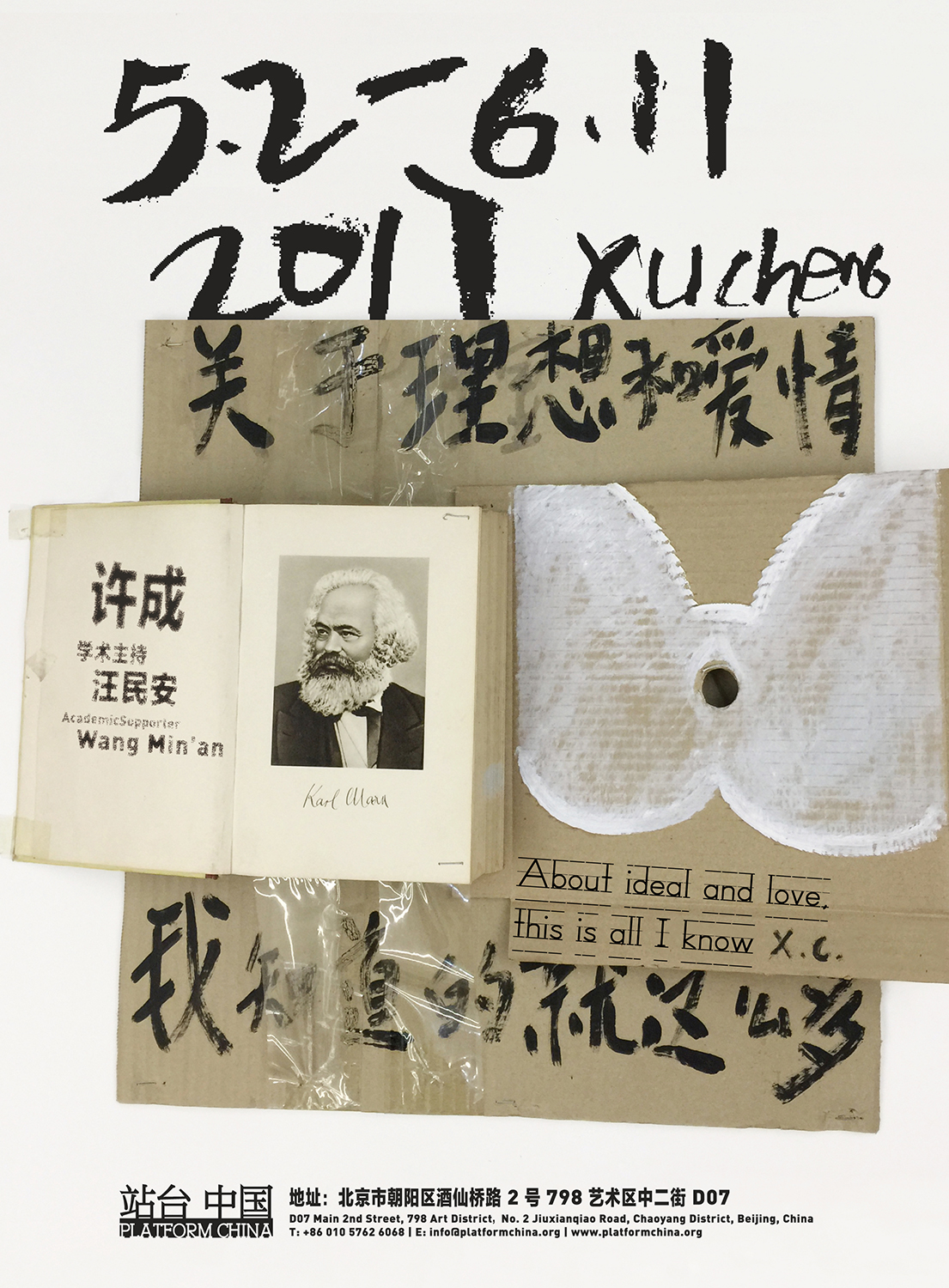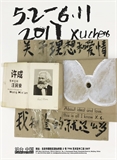
Xu Cheng has painted a great many figures. He paints them on corrugated cardboard. These coarse corrugated cardboard pieces form a backdrop for the nudes, which are evidently not the object of adulation or eternalization. They sprawl across the cardboard with wanton abandon. Xu Cheng has covered these unfolded boxes with rich colors, often large swaths of bright greens, reds or blues, to conceal the original color of the cardboard and the creases on its surface. The original color of the cardboard seems to have been concealed (although Xu Cheng sometimes leaves parts of the cardboard exposed), but the original creases still stubbornly show themselves. No matter how thick the paint, these creases are an ineradicable presence in the composition. That is to say, they are an organic component of the painting—they sometimes appear as lines inlaid into the painting, cutting straight across the image like brushstrokes; sometimes they are like crude divisions in a large painting, cutting it up into regions; sometimes they make the painting appear to be a collage of smaller paintings. In any case, these creases in the cardboard break through the packaging of the thick paint, and stubbornly enter into the interior of the painting.
Xu Cheng sometimes also intentionally paints straight lines on the cardboard that can stand in for the creases in the cardboard itself, and are often mistaken as such. In this way, the painting attempts to gain a sense of illusion. This is a game of painting: a game of mutual referencing between the traces of the object itself and the traces of the paintbrush. These creases and straight lines divide the regions of the overall painting, and the bodies in the paintings find themselves spread across different regions, emerging in divided form. One could say that a grid has been naturally applied to these bodies, especially in cases where the creases in the cardboard are readily visible. In this sense, Xu Cheng's bodies are not congruous organic wholes. They have been disintegrated, divided, compressed or concealed, and all of this has been done without Cubist or Surrealist methods. Many of his figures have no neck, their heads stacked directly and disproportionately to their bodies. He has enlarged certain parts of the body (especially the buttocks), while shrinking others (the head). Some parts of the body are left out altogether (in some paintings, the head is attached directly to the body without a neck), or certain parts of the body are altered (the head replaced with the head of a bird). Thus, these are not so much unitary bodies with organic, orderly growth as they are haphazard assemblages of organs from various bodies, organs affixed to other organs, and dismembered bodies attached together on the painting: a head attached to shoulders, feet attached to legs, hands attached to bodies, reproductive organs attached to legs... There are even more extreme assemblages, ones between humans and animals. These assemblages are so haphazard that they seem to barely dangle in place. In this way, the parts of the body are all independent. Their sense of organic belonging has been scrambled. The human body has become loose, powerless, ugly, and without vitality. They often appear in naked sensory form—these ugly bodies do not lead to any psychological depth, or any form of personalism. They are merely exposed in their animal carnality. In many of these works, Xu Cheng juxtaposes or even joins people with animals. They appear to be unified wholes, or perhaps the people are animals. Their poses, lusts and emotions are all animal; there is no hierarchal distinction between human and animal. Like animals, these people have no expressions, no drama, no laughter. Eventually, Xu Cheng simply just painted them from behind, and did away with their faces altogether.
Why does he paint figures in this way? Is this not an entirely new way to see the human body? Here, the body has been decentralized. Or one could say that the body has been dispersed, with each organ becoming independent. The face and the body can be together without the neck as a go-between. The legs stand right upside down without any assistance from the body. The hand emerges as only three fingers sticking out from the thigh. None of these organs are necessarily organic components of the body. These bodies of Xu Cheng's possess only the framework of the body. They are partial assemblages of organs that cause the flesh of the body to recede. Xu Cheng outlines this framework with flowing lines, and each organ presents itself through these lines. In this way, the flesh lacks its own density and texture—whether it is in the swordsman tangled in his white robes and lacking a clear face, or the silhouettes of the long-legged nude women. These recent paintings are filled with powerful, indomitable curved lines. These curves link with the straight lines of the cardboard while also interfering with and destroying them. They also present the outlines of the body. These curves are particularly adept at presenting the notions of legs and buttocks. In Xu Cheng's latest works, these buttocks, formed from the curved lines, become the center of the painting. We could even say that these are paintings about buttocks. He paints them as plump and supple. They are so large and supple that the other parts of the body have been compressed into insignificance. Xu Cheng often even stacks two butts together, a human one over an animal one, or two buttocks of different proportions in parallel at the center of the painting, as if shining towards the viewer’s gaze. These buttocks are dazzling. They take over the center of the painting with no reservations. Xu Cheng paints buttocks as pure round targets for the gaze, as if the gaze can focus only on this circle, only on the buttocks. This is absolute profane painting, the profaning of the human body, the profaning even of the viewing of painting. People always treat the viewing of painting as a form of cultivation, but now, viewing painting is merely looking at those lascivious legs, mounds of flesh and buttocks. The buttocks are intentionally exposed to the gaze so that the gaze has nowhere to hide. This is the greatest shaming of the gaze.
This profane painting, however, is not lewd. Lewd painting always aims to provoke desires, but Xu Cheng's paintings, filled as they are with nude bodies, sex scenes and even sexual organs, do not indulge those passions. They are not provocative or seductive—this is perhaps because they are ugly, or because they are brutal, or because they are powerless. The paintings are full of sex, but there is no pleasure in this sex, only powerlessness, no passion, only profanity. Nor is this a way of emphasizing the beauty of the human body from another angle. Many painters of the human body declare that figure painting is an expression of the beauty and freedom of the body, beauty and freedom that repress the evil imagination of sex. But Xu Cheng is neither of these. He is not using the body to provoke lust, or to evoke the beauty of the body. Instead, he is simply using the body as a profane device: the vulgarization of sex and beauty. When facing the nude, people are always pulled into an endless discussion of the tension between pornography and beauty, but here, such arguments vanish. Both are being discarded simultaneously. This is just profanity. Lust has lost all of its drive. If that is the case, what is the point of the nude, or the point of painting? We can only say that this is the profaning of the system of painting. Everything about painting has been profaned here. This is precisely why Xu Cheng is so obsessed with profane painting—profane painting is not bad painting. If bad painting always uses one aesthetic or value to defame another, or replaces the “good” with the “bad,” then profane painting is the total opposite. Profane painting cancels out all forms of values in painting. It cancels out both good painting and bad painting simultaneously, just as it cancels out both pornography and beauty in the nude. Here, the aim of painting is to invalidate all existing values of painting.
Profane painting is often completed through methods of play. These paintings are full of a sense of play. Play is present at every turn in Xu Cheng's painting. How could we define these paintings if not as a form of play? Those bizarre postures, dubious combinations of humans and animals, fatigued sexual organs, swordsmen flying inexplicably through the air, inverted legs, high heels, legs tangled in clouds, the strange fruit shoved into a glass, the man covered in wrinkled clothes and playing a green flute, the burning book, the garlic cloves withering in all directions, if all of these things are not games of painting, then what are they? Do these games of painting not render the practical themes and sacred conventions of painting useless? Does this not amount to the profaning of painting?

